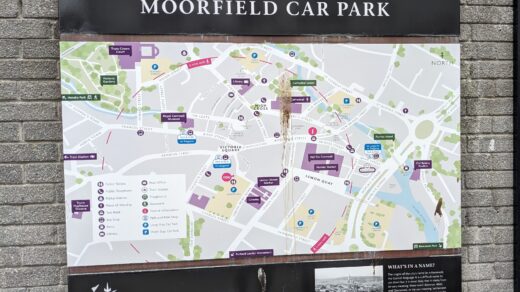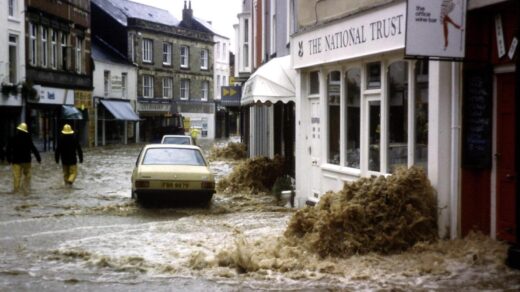All Power to Landscape
Why is the Mayor standing in a field screaming ‘TOLGARRICK! HINTERLAND!’?
With all this walking around, and with a summer remarkably free of pollutants – no vapour trails across the dawn sky; no rumbling of internal combustion ‘crocodile tail-backs’ emitting between traffic lights, something has emerged into the town’s consciousness.
Firstly, Truro is a market town set within a remarkably beautiful landscape which finds visible origins in the Great Fields of the early medieval period, and is dominated by two inter-related forces, rivers providing water for power, drinking, cleaning and scouring, and by agriculture, providing commerce, professions and wealth.
Whilst walking from Comprigney Hill to Coosebean above the River Kenwyn and below the Pencoose ridge, I found myself speculating if this was the path taken by millers and smallholders to attend church at Kenwyn each Sabbath, and occasionally to hurry in to town to witness a hanging at Comprigney, on the great Pydar Street which connects the Hundreds of Powder and Pydar, It is said that the corpses of felons hung in chains, pecked by crows, to serve as warning to travellers and pilgrims.
The early Victorians started the outward sprawling of Truro, creeping up the hillsides and out along the Kenwyn valley to Bosvigo, in terraces of cottages and town houses, following contours, and harnessing nature to their housing with light, as much as systems to create good public health, and pumps to obtain domestic water. The sewerage system was initially designed by Sylvanus Trevail, whilst Dr’s Carlyon and Barham became the first people in the world to apply the theory that clean water would prevent cholera and typhoid from spreading.
In the 1980s Truro began to spill over the tops of its surrounding hills. In the dying days of the unlamented Carrick District Council a new Truro plan emerged – which Mrs Armorel Carlyon dubbed the ‘BLOB’ map. This showed areas which, in the technical opinion of planners, could accommodate ‘growth’ in housing. These areas included 17 working farms. Such growth was being promoted (if not insisted upon) by successive governments that sold council houses but did not replace them, which failed (Mr Blair) to halt council house sales, did not restrain the acquisition of houses for 2nd homes, which ‘reformed’ the planning system (Mr Prescott et al), fuelled a boom that led to a crash that led to a boom (remember sub-prime mortgages?) and crash and….COVID 19!!!!
So, here we are – many more people loving the beauty of Higher Newham, Dudman and Nansavallon, the rolling medieval open fields of Coosebean, the garlic valley of Trennick, the promise of Tregurra Lane. Many many people are awaking to the at-risk tranquility and agricultural pastoral of Langarth and Tregavethan. In town itself we find hedgehogs invading Trafalgar roundabout, whilst Boscawen Park, the Duck Pond and privately owned Moresk Forest (where Tristan & Iseult hid from her angry husband, King Mark, before escaping on the Mopus ferry to Blanchelands and the mysteries of Kea – amongst other subtle things which have surfaced is the preponderance of Cornish language in the place names) are very popular, alongside Victoria Gardens and the newly acquired Coosebean Woods – a distinctive cultural beauty that prompts me to stand in Treyew Road and scream ‘TOLGARRICK’ at that copperfield’ sign, whenever I feel in need of therapy!
Secondly, in the arenas which discuss and form the Truro & Kenwyn Neighbourhood Plan (TKNP) there is much talk of boundaries – of finding a clear and definitive way to halt the march of Truro into its surrounding countryside; to contain the ravenous site-consumer before it guzzles up all the farms, barn-businesses, communities and homesteads that provide the wealth for Truro to manage, and the surplus income which our best and closest customers choose to spend in Truro, even though, in many cases they can do so more easily in the city of digital illusion (Internet).
Boundaries are anathema to many, and an essential defence to others. If a line is drawn, many lawyers will earn much money trying to break it down. However, perhaps there is another way! The TKNP has acknowledged the intense value of landscape in the life, health and culture of Truro, and has commissioned a ‘landscape appraisal’. This is a long, complicated and academic way of providing the means to defend those places which we feel are too beautiful, too life-enhancing, too economically important and naturally essential, to be buried under concrete, poisoned by fumes, or neglected by absentee owners of ‘options’. – or simply lost.
Perhaps it could and should be the landscape that defines the limits of Truro. Perhaps it is time for towns to empower their landscapes, to acknowledge that the wealth, demand and busy-ness of their surrounding rural hinterland (apparently, so I’ve heard, the word ‘hinterland’ is banned in Cornwall Council – God knows why!). It’s time for the empowerment of Nature and agriculture, for natural power and tidal rhythm, to determine the journey of Truro. We could be commissioning the TKNP Landscape Consultants to be recommending policies which will strengthen the setting to contain the predator, rather like the web demanding that its spider sits at its centre, using the web to sustain itself, but not providing so much that the spider grows and grows until it becomes bigger than the web which supports it – balance and common purpose!
And thus! There is the Mayor likening – for the very best possible reason – the town of Trurra – born in industry, trade and bridges – clean, healthy and safe – to a spider at the heart of a web. Let us empower the web so the spider may schemey – it’s a thought though, don’t you think?
TOLGARRICK!
HINTERLAND!





